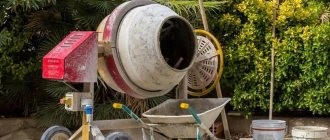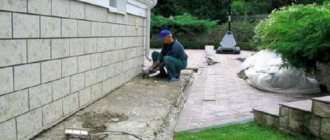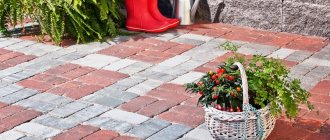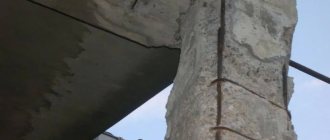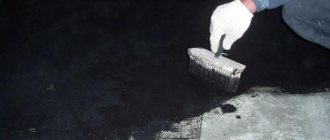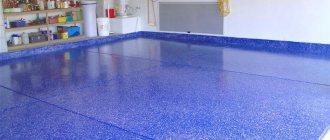Why is concrete processed mechanically?
Removing visible dirt is not the only reason for mechanical cleaning of concrete . This material has one characteristic feature: on the surface, approximately eight hours after the concrete mixture has set, a cement film or so-called cement laitance is formed, which is a mixture of soluble and insoluble salts - carbonates, sulfates, nitrates, chlorides.
The basis for the formation of this milk can be an aqueous solution of calcium hydroxide, which, after pouring concrete, comes to the surface and, reacting with carbon dioxide, turns into a water-insoluble film of calcium carbonate.
Cement laitance can also be formed from alkali metal salts present in concrete
When making a water-cement mortar, alkalis interact with other substances in the concrete mixture and, when reaching the surface, become carbonized (under the influence of carbon dioxide). Another reason for the formation of a cement film may be the improper use of mixing water in the production of concrete mixture .
The surface layer of cement laitance becomes a significant obstacle to obtaining a high-quality coating, which will subsequently be applied to improve the operational and decorative properties of the concrete structure.
If this layer is not removed, then the likelihood of peeling and violating the integrity of the screed, plaster and any other coatings increases significantly , since instead of a monolithic “concrete-covering” system, a three-layer system is obtained, in which there is an undesirable intermediate layer of cement laitance. Experts estimate the strength of such a structure to be no more than fifty percent of the required value, guaranteeing a long service life of the coatings.
In addition, if the concrete surface is not cleaned of cement laitance, then due to closed pores it will be impossible to obtain high-quality waterproofing. The waterproofing material simply will not be able to penetrate into the deeper layers of concrete, and therefore will not perform the functions assigned to it.
To clean concrete surfaces from cement laitance and various contaminants, the following mechanical methods are used:
- sandblasting;
- shot blasting;
- grinding;
- milling.
There is also a method of dry cleaning of concrete surfaces, which involves the use of manual and mechanical metal brushes, rollers and wire bristle brushes. The advantage of mechanical cleaning is that it can be used in cases where wet and expensive methods cannot be used . Correctly prepared concrete surface preparation is a prerequisite for high-quality performance of subsequent finishing work.
Concrete cleaning is carried out for the purpose of:
- preparing concrete for subsequent plastering. By increasing the adhesion of the porous wall and the building mixture, the shelf life of the finishing material increases by 2-3 times;
- removing old paint before applying a new paint coating;
- preparing the concrete base for installation of self-leveling floor;
- eliminating soot, soot and other contaminants after a fire, as well as other unforeseen situations;
- cleaning the concrete surface before waterproofing it;
- elimination of various types of biological corrosion. Fungus, mold and other harmful microorganisms are removed;
- removal of graffiti and petroleum products from concrete surfaces.
Concrete is also cleaned to obtain the necessary roughness of the concrete surface for applying protective compounds and decorative materials.
Why do you clean concrete and stone?
Cleaning concrete and stone surfaces is most often done to remove dirt. Due to the fact that concrete and stone have a porous structure, contaminants “eat” quite strongly into the surfaces of these materials, and it can be incredibly difficult to clean them.
Proper surface preparation is a necessary condition for the quality of subsequent construction and finishing work.
Surface preparation is also required in the following cases:
- Removing old paint from concrete before applying a new finishing layer;
- Creation of increased roughness to improve adhesion with new coatings;
- Preparation for application of protective compounds (fire retardant, anti-corrosion, water repellent, waterproofing);
- Removing soot and soot after a fire;
- Preparation of concrete bases for self-leveling floors;
- Identification of surface defects before repair;
- Roughening the material for decorative purposes.
Sandblasting
This method involves cold cleaning of various surfaces using abrasives. A high-pressure jet of air together with abrasive hits the surface being treated from the nozzle of a sandblasting machine and knocks off contaminants from it .
The result is a deep cleaning of concrete surfaces from debris, oil stains, paint and other contaminants. Abrasive particles with sharp edges make the surface rough, so putty, varnish, paint and other decorative coatings are easy to apply to it.
As a rule, sandblasting is used where any other cleaning methods are ineffective or too expensive. Sand removes soot, old paint, mold and even graffiti (aerosol drawings) from concrete or brick. This method also cleans reinforced concrete floor panels, walls and columns from unnecessary cement mortar, traces of formwork, etc.
Using sandblasting, you can clean the most inaccessible places and surfaces of any configuration . In addition, it successfully reveals small depressions, cracks, chips and other defects of the concrete surface, which greatly simplifies further repairs.
Sandblasting simultaneously with cleaning the concrete surface creates a specific microrelief on it, which increases the adhesion of the surface to any coating. The inconvenience is that after treatment the surface will have to be thoroughly cleaned with an industrial vacuum cleaner.
Sandblasting also opens the pores of the material before applying the waterproofing composition, so it penetrates deep into the concrete structure and provides it with a high-quality protective function throughout the entire period declared by the manufacturer.
The main advantages of sandblasting:
- high cleaning speed and relatively quick results. Due to the fact that abrasive particles bombard the concrete surface at high speed, dirt disappears from it literally before our eyes. A similar effect is completely impossible to achieve when using liquid cleaning solutions:
- long lasting cleaning effect . Surfaces cleaned by sandblasting take much longer to become dirty compared to surfaces treated by other methods.
The main disadvantage of sandblasting is the generation of large amounts of dust, which poses a danger to the health of the operator, as well as the performance of the equipment.
Types of sandblasting
There are several types of sandblasting:
- dry;
- wet;
- dust-free.
The most common is traditional dry cleaning, due to its maximum simplicity and minimal set of necessary equipment.
The main disadvantage of sandblasting is the high dust formation during work.
Wet sandblasting systems operate on the principle of directly supplying water to a mixture of air and abrasive or compressing an air-abrasive torch with a water cloud . In the first case, a mixture of abrasive and water is fed through a hose, and in the second, a stream of water enters a container with sand, and then the mixture of water and sand is pushed out through a nozzle under pressure.
This combination of technologies helps to clean concrete at a fairly high speed and with minimal or even no dust.
The downside of wet sandblasting is that you have to wait for the surface to dry before it can be coated with paint or any other decorative coating. In addition, the use of water is not always acceptable for cleaning some concrete surfaces , for example, when it is necessary to remove nitrate and sulfate efflorescence.
To avoid their dissolution in water and subsequent penetration into the soil next to the structure being treated, only dry cleaning of the concrete is carried out with dust extraction using a special vacuum cleaner.
With the advent of dust-free cleaning technologies, the possibilities for using sandblasting have significantly expanded, even in cases where people are in close proximity to the objects being treated.
The dust-free method of sandblasting completely eliminates the possibility of causing any harm to the health of those nearby, and also significantly reduces, and in some cases eliminates, the polluting factors that always accompany such work.
Sandblasting Equipment
The general scheme of devices for sandblasting involves the presence of a reservoir for sand or other abrasive, a compressor, a spray gun (sandblasting gun), a set of hoses (pipelines) through which the abrasive-air mixture and compressed air are transported.
According to the method of supplying sand to the nozzle, the equipment is divided into three types:
- suction (ejection) action;
- injection;
- gravitational
Compressed air in the suction unit enters the nozzle through the pipe, where it creates a vacuum. The sand is mixed with air, which accelerates it, and supplied through a nozzle to the surface being treated . In ejection units, sand is mixed with air immediately before leaving the sprayer. This equipment is simple in design and trouble-free in operation, but has low productivity.
In pressure units, sand flows from the hopper through a valve into a sealed chamber under air pressure (in simpler devices, sand is immediately poured into a container connected by a hose to the compressor). Then the sand is transported to the mixing chamber due to high pressure. Here it is picked up by the air flow, which comes directly from the compressor through the pipeline.
Due to vacuum, the abrasive is sucked from the hopper into the mixing chamber of the sprayer
The resulting mixture is directed into a head with a nozzle and from there it is thrown out in the form of a jet onto the surface to be treated. Double-chamber installations ensure continuous operation. They have a body divided into two parts (upper and lower), which are containers with a loading valve . Pressure-action units have high performance, but are distinguished by a rather complex design and fairly rapid wear of the nozzle and hoses.
In gravity-fed installations, sand is poured through a valve hole from the hopper into the mixing chamber spontaneously (under the influence of gravity). Here it is mixed with air and fed into the distribution nozzle.
Some types of this equipment involve mixing air with the abrasive immediately before leaving the nozzle. Gravity equipment is characterized by simple design, reliable operation and consumes much less compressed air than suction and discharge units.
Equipment for sandblasting can be open or closed, as well as mobile and stationary. To clean concrete structures, mobile open-type installations are used, most often with suction (ejection) action. Such equipment can only be worked in open areas or in rooms specially adapted for this purpose. The operator must use personal protective equipment.
The main advantages of such installations:
- ease of operation and maintenance;
- the ability to perform deep cleaning of objects of any size and shape;
- good maneuverability.
It should be noted that the performance of sandblasting equipment depends, first of all, on the technical characteristics of the compressor , so special attention should be paid to its selection. A correctly configured set of equipment for sandblasting and a compressor that is fully suitable for the task allow you to obtain high speed and high quality concrete cleaning with minimal costs.
Abrasives used
Various abrasives can be used for sandblasting. The choice of abrasive type depends on the initial condition of the concrete surface, as well as the desired result.
The following materials can be used for sandblasting:
- ordinary sand , which is also called river sand. This sand must be sifted before use;
- sand, which is specially mined in quarries . This sand has smaller grains than river sand. Before use, it must be sifted and washed;
- quartz sand for industrial use . This sand is obtained from river sand by sifting and separating into different fractions. The cost of this sand due to additional labor costs is significantly higher than ordinary river sand (on average 3 times);
- sand obtained by crushing quartz rocks . This sand has an acute angular shape, which makes it a more effective material for sandblasting compared to ordinary river and quartz sand. Accordingly, sand consumption is reduced;
- Nickel slag and cooper slag are abrasives obtained from nickel and copper production waste. These abrasives are superior in strength characteristics to ordinary sand, but comparable in cost;
- garnet or garnet sand , which is significantly superior to quartz in hardness, but has a higher price;
- electrocorundum . This abrasive is an artificially synthesized material containing oxides of iron, calcium, silicon, aluminum, etc. It is considered the hardest among abrasives used for sandblasting.
Electrocorundum particles are practically not damaged during processing, so after sifting they can be reused
The abrasive is a very important element of the sandblasting system. The quality of cleaning the concrete surface directly depends on its choice. For each specific case, it is necessary to select an abrasive of the appropriate shape, size, hardness and density .
Abrasive form
There are several different forms of abrasives that can be used to create different surface profiles. Sand used for cleaning concrete can be round, oblong or angular. River and sea sand, due to the erosive effects of water, turns out to be more rounded or oblong, and sand from quarries has sharp corners and has cutting properties .
Particles with sharp corners are used to remove old coatings. They leave distinct depressions and peaks on the surface. Rounded abrasive particles form pits on the concrete surface.
Abrasive sizes
Depending on the size of the fractions, the following classification is used:
- dusty quartz. The particle size is less than 0.1mm;
- sand. The particle size of this abrasive is in the range of 0.1 – 0.4 mm;
- coarse sand with particle sizes 0.5 - 1.0 mm;
- quartz chips consist of particles larger than 1.0 mm.
Compared to sand of natural origin, quartz sand has such advantages as uniformity and increased intergranular porosity. But the content of quartz in an unbound form quite significantly limits the use of sand for cleaning concrete , since fine-crystalline dust, which is formed as a result of the destruction of sand particles, can cause a very dangerous disease - silicosis.
Many countries today prohibit the use of abrasives that contain more than 1% quartz in unbound form. The most justified is the use of quartz sand for cleaning concrete structures using a dust suppression system.
Nickel slag and cooper slag, unlike quartz sand, contain less than 1% quartz, so they can be used for sandblasting concrete with open-type installations . These materials have higher dynamic strength and particle hardness and, therefore, a low level of dust formation. They can be reused.
Coarse abrasives are used to remove heavy corrosion, multiple layers of paint and grout residue. Using medium-sized granules, remove surface rust, loose paint or a thin layer of scale. The small granules are ideal for cleaning thin metal, plastic, wood and other sensitive surfaces.
When using large granules, fewer particles hit each square centimeter of area and therefore not all surface areas will be treated . For this reason, large granules are not always able to clean a surface faster than small ones, although they cut much deeper into the surface.
Hardness of abrasive particles
The hardness of steel shot is measured using the Rockwell scale and is designated Rc. Steel shot can have a hardness from 35 to 65 Rc
The hardness of abrasive materials (with the exception of metal abrasives) is measured using the Mohs scale. There are 10 degrees of hardness. Materials with the first degree of hardness are soft, like talc, and with the tenth - hard, like diamond .
It is very important to understand that if the abrasive is harder than the coating, but softer than the base, then it will be able to remove the old coating. If the abrasive is harder than the substrate, it will leave a profile on the surface being treated, and if it is softer than the substrate, it will simply clean the surface of dirt without removing the coating.
Density
This characteristic is not the most important for an abrasive material, but its role increases significantly in the case when materials that are similar in other parameters differ greatly in density. That is, the greater the density of abrasive particles, the more energy they will transfer to the surface being treated . The difference in density between slag and sand is 2 kg/liter. Denser particles, under equal conditions, create a deeper profile, which is not always desirable. Higher density abrasive particles are better at removing hard and stubborn coatings.
The choice of consumables for a sandblasting installation is influenced by factors such as:
- the thickness of the coating or layer of contamination that needs to be removed. If you choose an abrasive with small granules and low hardness for a durable and thick layer of removed dirt and coating, then you simply may not get the desired result;
- hardness of the base material being processed . For hard substrates, it is recommended to choose a harder abrasive and, conversely, for soft ones - a less hard one, in order to avoid damage to the surface being treated;
- surface condition after treatment . In the case where there should be no dents or chips on the cleaned surface, you should choose abrasive materials with a finer fraction for its processing;
- with sandblasting speed . Solid abrasive particles with sharp edges provide a faster cleaning speed than similar ones with a rounded shape;
- possibility of collecting and reusing abrasive . If this is not possible, then it is more advisable to use inexpensive materials such as quartz sand, nickel slag and cooper slag.
Comparison of the main parameters of abrasive materials will help you make the right choice.
Purpose of concrete cleaning
If the concrete has not been treated and contaminants appear on its surface, it must be thoroughly cleaned. Cleaning not only restores the aesthetic appearance of structures, but also allows you to get rid of any kind of contamination and prevent destruction of the concrete structure, and also prepares the surface for the application of protective and waterproofing materials.
The fact is that applying protective or decorative coatings to surfaces contaminated with fats, mineral salts (nitrates, chlorides, sulfides, hydrocarbons and others), biological contaminants is an absolutely useless exercise. The coating will not adhere, and the destruction of concrete will worsen.
Shot blasting of concrete
Shot blasting is used mainly in preparing the floor surface in monolithic construction . It is used quite rarely for the preparation of ceilings and walls. Using special installations, the top layer, which consists of so-called cement laitance, is removed from concrete floors, as well as weakened, easily removable concrete fragments and various contaminants.
Shot treatment is carried out immediately before applying a protective or decorative coating. In this case, the concrete surface must be dry
Shot blasting has the following advantages:
- ensuring good adhesion of the applied coating to the concrete base;
- high-quality removal of various contaminants from the concrete surface;
- exposure of the solid filler of the base, which ensures strengthening of the surface layer of the concrete surface;
- detection of hidden defects on the concrete surface (cavities, cracks, etc.);
- leveling the base.
In addition to processing new concrete, shot blasting technology is indispensable for cleaning surfaces from old polymer and paint coatings. In addition, this technology allows you to create a rough surface. After shot treatment, the adhesion area increases by at least 2-2.5 times compared to an untreated concrete surface .
Surface treatment with shot occurs as follows. At the bottom of the shot blasting unit there is a sealed working chamber. The steel shot flows from this chamber onto a bladed disc which rotates at a very high speed. Then the shot, under the influence of centrifugal force, hits the surface being treated and thus removes dirt and defective fragments of concrete from it.
The resulting debris, together with the abrasive shot, is sucked up by a special vacuum cleaner and enters the separator, where the shot is separated from the debris. The shot then goes back into the loading hopper and the work process is repeated. The degree of surface cleaning depends on the speed of movement of the unit and the supply of shot to the supercharger.
The shot produces its destructive effect not at the moment when it falls on the concrete surface, but at the moment of elastic rebound (ricochet). With each rebound, the shot transfers part of the kinetic energy to the concrete surface, which, as it were, explodes this surface from the inside due to elastic forces.
Moreover, the weaker the molecular bonds in the surface layer of concrete, the stronger its destruction occurs, except for those cases when the material is completely viscous/soft and therefore no rebound of the shot occurs.
The closed cycle of operation of the shot blasting unit ensures fairly high productivity and efficiency. In one hour, the installation on average can process 40-150 square meters of metal surface or 50-250 square meters of concrete floor . When using special trunks and sleeves, productivity can reach 500 square meters.
But despite all the advantages of shot blasting, it is not always the most effective method for cleaning concrete surfaces.
This technology is not used in cases where:
- topping must be removed;
- The thickness of the polymer-based self-leveling floor is more than 5 mm.
Shot Blasting Equipment
Shot blasting will not cope with oily contaminants in concrete
The main elements of a shot blasting plant are:
- shot blasting unit;
- compressor;
- abrasive component.
In addition, the package includes shot collectors and dust collection hoses.
There are two types of this equipment:
- closed type machines . Used for processing relatively small parts in confined spaces;
- open type installations . They are used to process large concrete surfaces and metal structures.
The shot inside the machine is accelerated to 100 m/s, and then directed to the surface being treated and knocks off old coating and other contaminants. The exfoliated concrete particles together with the shot enter the separator, from which the debris goes into a special container, and the shot back into the machine.
Shot blasting plants are closed type equipment . The shot is used until its size becomes so small that the separator filters it out along with the debris.
Depending on the volume of permissible daily work, shot blasting plants are divided into:
- manual with a capacity of less than 50 square meters;
- medium scale (250 sq. meters). They are electrically driven and speed adjustable;
- large scale (750 sq. meters);
- processing areas of many thousands.
The angle of attack of the jet can vary depending on the type of surface being treated. The average amplitude is 15-85 degrees. In addition, modern shot blasting machines, in which super-powerful flows of air-abrasive mixture operate on the micro-cut principle , compare favorably with sandblasting units operating on the crushing principle. This feature of shot blasting equipment allows you to process any, even the most fragile surfaces, such as glass, ceramics or porcelain.
Consumables
The following types of shot are used for shot blasting:
- crushed cast iron . Such shot is produced from white cast iron by melting and subsequent granulation. The resulting spherical granules are cooled, split and annealed;
- with cast steel . It can be low (LC), medium (MC) and high (HC) carbon content. Each of these types differs in manufacturing technology and chemical composition, which determines the advantages and disadvantages of shot;
- steel chopped . It can be cylindrical or spherical. The cylindrical one is obtained by cutting steel wire, and the spherical one is obtained by rolling chopped cylindrical wire;
- steel crushed . Made from steel alloys with a martensite structure. Depending on the hardness there can be three types: G, GL, GH;
- aluminum shot;
- ceramic;
- glass balls;
- plastic shot , mainly polyamide, polycarbonate, aminoaldehyde and melamine resins.
Plastic shot can be cubic or cylindrical
Methods for cleaning the surface of concrete structures (part 3)
- home
- »
- About company
- »
- Publications
- »
- Methods for cleaning the surface of concrete structures (part 3)
Cleaning the surface of concrete structures and structures is done in several ways:
- Mechanical.
- Sandblasting.
- Shot blasting.
- Chemically.
- Water under pressure.
- Ognev.
Separately, it is worth highlighting the cleaning of the surface from biologically active substances and the cleaning of metal elements.
Surface preparation is done mechanically using brushes, diamond cups, milling cutters, hammers and grinding wheels. For this processing method, tools of varying power are used. However, many of them leave microcracks on the surface, which is undesirable for some materials.
There are two types of sandblasting cleaning method: dry and wet. It is the most economical and suitable for processing structures of various configurations. The dry sandblasting method is harmful to human health and requires washing the surface. The most optimal method is wet sandblasting. To clean using this method, water, an abrasive material (usually sand) and compressed air are used.
Shot blasting method of surface treatment. It is more often used when preparing horizontal surfaces. However, this is one of the most expensive cleaning methods.
Chemical cleaning method. Previously, this method was quite popular in the preparation of structures in construction, but this process is quite difficult to manage. When using it, it is almost impossible to achieve uniform cleaning of the surface of structures. Heavily contaminated structures require pre-treatment. The dry cleaning itself is carried out with hard brushes, and at the end of the work the surface of the structures is washed.
Pressure washing of concrete structures is carried out when there is rust on metal elements. For this surface cleaning technology, various types of installations are used depending on the level of liquid pressure. Cleaning with water under pressure does not affect the structure of concrete. It is most preferable when applying cement-based waterproofing materials.
Fire processing method. This is the most ancient cleaning method. As a rule, it provides a processing depth of up to 6mm. The flame temperature must be below 3200°C.
Biologically active substances on the surface of concrete structures require a special method of cleaning with steam or hot water. As a rule, this technology is combined with mechanical processing.
Concrete grinding
The main purpose of grinding is to clean and level concrete surfaces. Using this procedure, cement laitance is removed from new concrete, which impairs the adhesion of the concrete base and does not allow the application of a protective or decorative coating to it. Sanding of a fresh screed is carried out approximately 10-14 days after it is poured.
Grinding also helps remove any dirt from the concrete surface and smooth out chips and cracks . In any case, after grinding, a fresh layer of concrete is exposed with very high adhesion to various polymer materials that form the finishing coating.
Concrete grinding is carried out in two stages. First, 4-5 days after pouring the concrete mixture, preliminary grinding is performed, and after the concrete has completely hardened (28-30 days after pouring), final grinding is performed. Concrete, despite its fragility, is a fairly durable material, so grinding is most often performed with a special diamond-coated tool. Diamond tools are installed on grinding machines with powerful motors , since they must rotate at a very high speed.
It is not recommended to use hand-held equipment for grinding concrete. This is due, first of all, to the limited capabilities of such equipment, as well as to the formation of a large amount of dust during manual grinding. Hand-held devices can only be used to treat areas that are difficult to reach by professional machines .
The size of the abrasive on the cutting edges of the grinding tool is of great importance, therefore, all consumables must indicate the grain size, which determines the quality of the resulting surface.
The grain size of the tool is selected depending on the grinding stage:
- 25-40 – for rough initial leveling of the concrete surface;
- from 400 – for grinding concrete, providing it with smoothness and additional strengthening;
- from 1500 – for final polishing of concrete.
The standard concrete grinding process consists of the following steps:
- Assessment of the condition of the concrete surface. If necessary, repair all cracks and other defects using epoxy mastic.
- If metal embedded elements protrude from the concrete, they are carefully cut off with a grinder. The fittings must also be coated with an anti-corrosion compound;
- Applying a strengthening compound to close the pores in the monolith. If the concrete surface is planned to be polished to a glossy shine, the impregnation is applied immediately before this stage.
- The actual grinding with abrasive tools of different grain sizes until the surface of the required quality is obtained. At the end of the work, the concrete surface is cleaned of dust and covered with a protective compound.
Sandblasting technology for concrete and stone
Sandblasting of concrete or stone surfaces is carried out using mobile units. A jet of abrasive under high pressure hits the surface being treated and knocks off contaminants, which are immediately blown out of the treatment area.
Depending on the task at hand (removing dirt, concrete sludge, or imparting increased roughness), a suitable abrasive is selected and the required pressure is used. This makes it possible to achieve the desired effect in a short period of time, without spoiling the base material.
Sandblasting not only cleans, but also creates the desired microrelief. After sandblasting the surface of concrete and natural stone, the adhesion of the base to the coating increases, and the applied protective or decorative compounds (paint, water repellent) last much longer.
Sandblasting of concrete surfaces allows you to effectively process not only flat surfaces, but also embossed and hard-to-reach areas.
Concrete milling
This type of mechanical processing is used to prepare concrete bases for floors, for end-block coverings, concrete, stone, ceramic, metal and other slabs, self-leveling coatings, and rolled materials.
Using milling, you can create the necessary evenness of a concrete floor without resorting to the installation of an additional leveling screed
In addition, milling can be used to reduce the time required for grinding mosaic and concrete floors , reducing the labor intensity of their installation, as well as for installing concrete coatings with a special relief during the construction of roads, bridges, airfields, spillways, etc.
The relief of the concrete surface, created using milling, improves the grip of vehicle wheels, increases the durability of concrete structures in conditions of cavitation destruction when fluid moves at high speed (dam spillways).
Milling of concrete is carried out for the purpose of:
- rough elimination of large irregularities and sagging on concrete surfaces, the height of which ranges from 5 mm to 2 cm;
- removing the top layer of concrete 3-10 mm thick for various reasons;
- lowering the elevation of a section of concrete floor, creating a slope;
- removal of old concrete, heavily contaminated with fuels and lubricants;
- removal of low-quality cement-sand screeds;
- removal of old or deteriorated polymer coatings;
- removing the hardened top layer (topping) before installing the polymer coating.
If the surface is slightly contaminated, it is sufficient to treat it with a sandblaster followed by blowing off the dust with a jet of compressed air.
To clean surfaces, the Kuibyshev branch of the Orgenergostroy Institute has developed a set of mechanisms that performs the entire range of work.
The water-air nozzle (Fig. 9) is designed to remove dirt, dust, cement film, its productivity is up to 40 m2 of surface per hour, weight - 2.6 kg. The nozzle of the water-air nozzle is kept at a distance of 30-40 mm from the surface to be treated at an angle of up to 30° to it. Compressed air with water, leaving the nozzle under a pressure of 4-5 kg/cm2, cleans the surface.
Rice. 9 Air nozzle 1 - nozzle; 2 - pipe; 3 - tee; 4 - taps; 5 - nipples
Rice. 10 Pneumatic scraper 1 - brush holder; 2 — brush; 3 - handle; 4 - tap; 5 - nipple
For additional cleaning, a pneumatic scraper is used (Fig. 10). The reciprocating motion lifts dirt off the concrete and is blown away by compressed air released from a hole at the end of the hollow handle. Air flow - 64 m3/min. Scraper productivity is up to 12 m2 of surface per hour, weight is 1.8 kg.
To clean surfaces and reinforcement at joints, a small-sized hydro-sandblasting machine with a vacuum gun can be recommended (Fig. 11). It works on the principle of an ejector. Sand is sucked into the gun chamber from a 42 liter nutrient tank. The upper cone of the tank has a loading neck with a removable mesh for control sifting
Rice. 11 Small-sized hydrosandblasting apparatus 1 - pistol; 2 - nozzle; 3 — air tip; 4 - taps; 5 - pipe; 6 - hose
sand A mixing box with a regulator is welded to the lower cone of the tank. The weight of the device is 14.3 kg, the productivity is up to 26 m2/h. Sand consumption is 0.7 l/min, air consumption is 4 m3/min, water consumption is 2 l/min.
For cleaning vertical surfaces, a mechanism proposed by the instructor of the Kievorgstroy trust V.K. Shadyr can be recommended. The mechanism is called a hydropneumatic washer (Fig. 12). Compressed air and water enter the nozzle. A stream of water coming out of the nozzle nozzle under a pressure of 4-5 kg/cm2 washes away dust and dirt from the surface, and additional cleaning is carried out with metal brushes. Some of the water falls on the brushes and washes them.
If a significant amount of moisture accumulates on the horizontal surfaces of the tanks due to unevenness, then the water is removed by vacuum suction before drying. For suction, we recommend a machine created by the SKV Mosstroy team; per minute, you can remove 6-7 liters of water, which is 0.42 m3/h. The machine consists of a tank-trap for collecting water, equipped with two wheels and a support heel for stability, a pump with an impeller with a diameter of 220 mm and a rotation speed of 9000 rpm, an AOL-22-2 electric motor with a power of 0.6 kW and a wedge-belt booster transfers. Water is suctioned through suction cups due to the vacuum (1000 mm of water column) formed at the intake end of the suction rubber hose.
Drying the surface is usually done with a burner torch running on liquid or gaseous fuel.
Rice. 12 Device for cleaning and washing vertical surfaces 1 - nozzle; 2 — hose for supplying compressed air 0 8 mm; 3 - water pipe 021 mm; 4 - metal brush
Security measures
When carrying out mechanical processing of concrete, a large amount of dust is generated, which poses a great danger to the health of both the operators of the equipment used and people who may be in the work area. Dust entering a person's lungs can cause a very serious occupational disease - silicosis .
To avoid this, the operator must use special protective equipment: overalls made of thick fabric, canvas gloves, a sandblaster’s helmet with an external air supply for the respiratory system.
Mechanical processing of concrete is a fairly noisy process, so hearing organs should be protected with earplugs. To protect other operating personnel and the environment from dust, special ventilation units are used - dust collector filters. The main task of such filters is to clean the air from dust generated in the work area.
It is also dangerous if a jet of air containing an abrasive hits a person . Abrasive particles move at speeds of more than 650 km/h. Therefore, it is quite obvious that a jet of such power hitting a person’s body can cause injury or even cause death.
Preparing concrete surfaces for painting
Before carrying out cosmetic work, all surfaces are prepared, including the concrete wall. It must be dry and clean: without wallpaper, paint, decorative coatings. Chemicals are used to remove the old paint layer. For example, the remnants of the old coating are removed with a spatula using alkali. Next, we’ll talk about all the stages of preparing the concrete surface.
Stages of cleaning concrete walls
1. Check the concrete surface for stains, dirt and dust.
• A 5% solution of soda ash is good for removing grease stains and soot marks. It is prepared as follows: add 400 grams of soda to 10 liters of water. • A solution of copper sulfate 15% removes rust stains. Then the surface is dried and primed. • White nitro enamel or rosin hides strong rust stains well. • There are various stain removers available on the market.
2. Concrete is rough and rough, so it is sanded with coarse sandpaper in preparation for an even application of paint or other material.
3. Take a roller or brush and apply a primer.
4. If there are any holes or cracks left, we putty them. When purchasing, you need to choose a putty specifically for concrete surfaces. The first layer is dirty, the second is finishing.
5. Sand with fine-grained sandpaper, trying to give the surface a smooth, even shape.
• Remove dust from grinding and cover with primer in 2-3 layers. The prepared paint is added to the last layer. • Drying oil is used before painting with oil paints. • Soap maker is used for subsequent liming or decorating with adhesive paint. Add 3 kilograms of chalk to a bucket of primer.
Methods for cleaning the surface of concrete structures
Concrete structures and surfaces are cleaned in different ways: chemical, water pressure, sandblasting, mechanical, fire, shot blasting. Also sometimes they are cleaned of metal elements and biologically active substances with hot water and mechanical methods.
• Mechanical method:
Diamond bowls, grinding wheels and brushes are used. The power of the tool can be any, and the higher it is, the greater the likelihood of leaving cracks on the surface;
• Wet and dry sandblasting:
Suitable for cleaning complex surfaces. For the economical wet method, water and sand are taken and supplied under compressed air. Dry is harmful;
• Shot blasting:
Allows you to clean a horizontal surface, but is expensive;
• Cleaning with chemical reagents:
The method is difficult to manage and expensive. Requires pre-treatment of heavily contaminated concrete surfaces. Clean with hard brushes and rinse thoroughly when finished;
• Cleaning with water pressure:
Fluid pressure may vary. In this way, rust is removed from metal elements. Then it is convenient to apply cement-based waterproofing;
• The most ancient is the fire method:
Treated to a depth of 6 mm with a flame of 3200°C.
Price
The cost of work depends, first of all, on the initial state of the concrete surface and its strength, as well as on the scope of work, the type of equipment and consumables used.
Cost of services for mechanical processing of concrete surfaces:
| Name of works | Cost, rub/m2 |
| Milling up to 3 cm deep | 620 |
| Pre-grinding | 180 |
| Final sanding | 140 |
| Removing decorative coating by sanding | 260 |
| Sandblasting concrete surfaces | 220 |
| Cleaning facades after a fire | 150 |
Sandblasting of concrete surfaces is used for:
— removing old paint from concrete; — preparing concrete for painting; — preparing concrete surfaces for plastering; — preparation of the base for self-leveling floor; — preparing concrete for waterproofing; — cleaning concrete surfaces after a fire; — cleaning the concrete surface from efflorescence, mold, graffiti, etc.
sandblasting of concrete with reinforcement are already prepared for the application of anti-corrosion compounds.
After sandblasting the stone, the surface will be matte. Therefore, stone sandblasting should not always be used for polished stone slabs or decorative elements. On the other hand, after cleaning natural stone , masonry or finishing that emphasizes the texture looks great: the color becomes richer, dirt is removed from the pores, and a texture that is pleasant to the touch is obtained.
conclusions
Mechanical methods of processing concrete allow not only to clean it of various contaminants and old coatings, but also create the necessary surface microrelief, which increases the adhesion of the concrete base with a protective or decorative coating.
After this treatment, coatings last much longer. At the same time, sandblasting has certain advantages when preparing hard-to-reach and curved surfaces .
Abrasive blasting methods for processing concrete are also used in cases where it is undesirable to use those mechanical types of concrete cleaning that can polish its surface. A smooth surface has a fairly low level of adhesion, which can become a problem when using certain types of protective coatings and waterproofing materials.
The process of shot blasting a concrete floor is shown in the video:
Cleaning a concrete surface with sandblasting
To prepare the concrete surface for the subsequent application of protective or decorative coatings, chemical or mechanical methods are often used, but the most effective, versatile and productive is concrete sandblasting .
Sandblasting concrete allows you to get rid of rust, efflorescence, soot, old paint, remnants of plaster, putty, dirt and atmospheric deposits.
When cleaning the surface of concrete , it is given increased roughness. This leads to improved adhesion to paintwork materials, primers and plasters, which significantly increases the service life of the applied compounds.
Concrete sandblasting allows you to reach the most inaccessible places and successfully identifies cracks, small chips and depressions for further repair.


